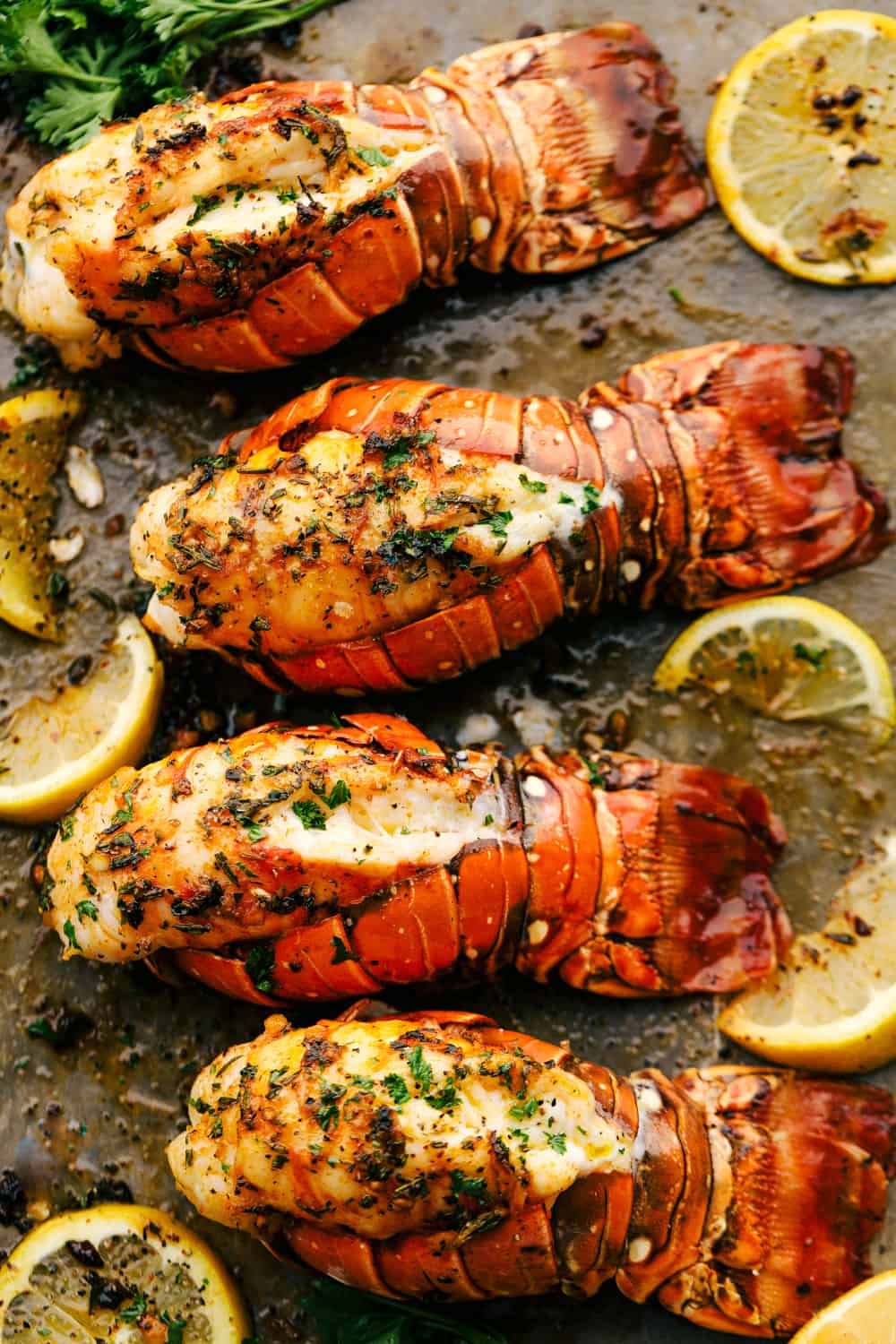Lobster tails are often seen as a luxurious and complicated dish, reserved for fancy restaurants and special occasions. But what if we told you that cooking succulent, mouthwatering lobster tails at home is surprisingly easy? With the right techniques and a few simple ingredients, you can create a restaurant-quality meal that will impress your family and friends, without the hefty price tag or hassle of reservations. This guide will walk you through everything you need to know about how to cook lobster tails perfectly every time, focusing on broiling for a quick and delicious result.
Why Cook Lobster Tails at Home?
Bringing the taste of the ocean to your kitchen is more rewarding than you might think. Cooking lobster tails at home offers several advantages:
- Cost-Effective Indulgence: Restaurant lobster dishes can be expensive. Cooking them yourself significantly reduces the cost, allowing you to enjoy this delicacy more often.
- Ultimate Freshness Control: You choose the lobster tails, ensuring they are fresh and of the quality you desire.
- Customized Flavors: Home cooking allows you to tailor the flavors to your exact liking. Whether you prefer a classic garlic butter sauce or want to experiment with herbs and spices, the culinary control is in your hands.
- Impressive Yet Easy: As you’ll discover, cooking lobster tails is not as daunting as it seems. It’s a surprisingly straightforward process that yields impressive results, perfect for elevating any meal.
- Perfect for Special Occasions or a Weeknight Treat: Whether it’s Valentine’s Day, an anniversary, or simply a desire to make an ordinary weeknight feel special, homemade lobster tails fit the bill perfectly.
Choosing the Best Lobster Tails
The foundation of a great lobster tail dish is, of course, the lobster itself. Here’s what to look for when purchasing lobster tails:
- Cold Water Lobster is Key: Opt for cold water lobster tails whenever possible. These are generally considered to be sweeter and more tender than warm water varieties.
- Check for Sodium Tripolyphosphate: Avoid tails that have been soaked in sodium tripolyphosphate. This additive can give the lobster a rubbery texture and a slightly ammonia-like taste. Read labels carefully or ask your fishmonger.
- Inspect the Meat’s Appearance: The lobster meat should be white and firm, without any discoloration. Discoloration can be a sign of poor quality or improper handling.
- Size Matters (Consider Your Needs): Lobster tails are sold by weight. Consider the serving size you need. A 5-6 ounce tail is a good individual serving, while larger tails can be shared or served as a more substantial main course.
Essential Ingredients for Perfect Lobster Tails
For this broiled lobster tail recipe, you’ll need a handful of simple, flavorful ingredients that you likely already have in your kitchen:
- Lobster Tails: The star of the show! Choose based on the guidelines above.
- Butter: Unsalted butter is best as it allows you to control the saltiness of the dish. It forms the base of the rich and flavorful sauce.
- Garlic: Fresh garlic cloves, minced, are crucial for that classic garlicky butter flavor.
- Fresh Herbs: A blend of fresh thyme, rosemary, and parsley adds aromatic complexity and freshness. Dried herbs can be substituted in a pinch, but fresh herbs truly elevate the dish.
- Paprika: Adds a subtle smoky note and a touch of color to the butter sauce.
- Salt and Pepper: To season the lobster meat and enhance all the flavors.
- Lemon Wedges (Optional): For serving, a squeeze of fresh lemon juice brightens the richness of the lobster and butter.
Step-by-Step Guide: How to Cook Lobster Tails
Broiling is a fantastic method for cooking lobster tails because it’s quick, easy, and results in beautifully cooked, tender meat with a slightly browned top. Here’s how to do it:
Preparing the Lobster Tails
- Preheat Your Broiler: Set your oven to broil and position the top rack about 4-5 inches from the heating element. Preheat the broiler while you prepare the lobster tails.
- Butterfly the Lobster Tails: This technique not only looks elegant but also helps the lobster cook evenly and allows the delicious butter sauce to penetrate the meat.
- Using sturdy kitchen shears, cut down the center of the top of the lobster shell, starting from the cut end towards the tail fin, but stop before the fin.
- Carefully separate the shell slightly and loosen the lobster meat from the shell membrane underneath using your fingers or a spoon.
- Gently pull the lobster meat upwards and out of the shell, keeping it attached at the tail fin.
- Close the shell halves underneath the meat, resting the meat on top of the shell “bed”. This creates that beautiful, fan-like presentation.
- Season the Lobster Meat: Lightly season the exposed lobster meat with salt and pepper.
Making the Garlic Herb Butter
- Melt the Butter: In a small, microwave-safe bowl or saucepan, melt the butter completely.
- Infuse with Flavor: Add the minced garlic, paprika, thyme, rosemary, and parsley to the melted butter. Whisk to combine all ingredients evenly.
Broiling to Perfection
- Baste Generously: Using a brush, generously spread the garlic herb butter sauce over the exposed lobster meat of each tail. Ensure each tail is nicely coated.
- Broil: Carefully place the prepared lobster tails on a baking sheet. Broil for approximately 8-10 minutes, or until the lobster meat is opaque, white, and slightly browned on top. The cooking time will depend on the size of your lobster tails, so keep a close eye on them.
- Check for Doneness: The lobster meat is done when it is firm, opaque, and reaches an internal temperature of 145°F (63°C). Use a meat thermometer to check the thickest part of the meat.
- Serve Immediately: Once cooked, remove the lobster tails from the oven and serve immediately with lemon wedges and extra melted butter, if desired.
Mastering the Butterfly Technique
Butterflying lobster tails is a simple skill that elevates both the presentation and cooking of your dish. Here’s a more detailed look at the butterflying process:
- Shell Side Up: Place the lobster tail shell-side up on a cutting board, with the tail fin pointing away from you.
- Cut with Kitchen Shears: Using sharp kitchen shears, cut lengthwise down the center of the shell, from the cut end towards the tail fin. Stop cutting just before you reach the tail fin.
- Loosen the Meat: Flip the lobster tail over. Gently use your fingers or a spoon to separate the lobster meat from the thin membrane attaching it to the shell. Be careful not to detach the meat completely.
- Pull Meat Through the Cut: Flip the lobster tail back shell-side up. Gently pull the lobster meat up and through the cut you made in the shell. The meat should still be attached at the tail end.
- Rest on the Shell: Arrange the lobster meat so it rests on top of the opened shell halves. Shape it slightly to create a visually appealing presentation. The shell now acts as a cradle for the meat, preventing it from curling up during cooking and creating a beautiful “butterfly” effect.
Broiling Time and Temperature for Lobster Tails
Getting the broiling time just right is crucial for tender, juicy lobster tails. Overcooking will result in rubbery, dry meat, while undercooked lobster is unsafe to eat and lacks the desired texture.
- General Broiling Time: A good rule of thumb is to broil lobster tails for approximately 1 minute per ounce of tail weight.
- Distance from Heat: Position the oven rack so the lobster tails are about 4-5 inches from the broiler. This distance ensures they cook through without burning on the top.
- Visual Cues: Watch for visual cues. The lobster meat will transition from translucent to opaque white as it cooks. The tops may also develop a light golden-brown color from the butter.
- Meat Thermometer is Your Friend: For guaranteed perfect doneness, use a meat thermometer. Insert it into the thickest part of the lobster meat. Aim for an internal temperature of 145°F (63°C).
- Adjust for Size: Smaller lobster tails (under 6 ounces) might cook in 7-9 minutes, while larger tails (over 6 ounces) may take 8-12 minutes. Always monitor closely and adjust broiling time as needed.
Alternative Cooking Methods for Lobster Tails
While broiling is a fantastic method, there are other delicious ways to cook lobster tails:
- Baking: Baking is similar to broiling but uses indirect heat, resulting in gentler cooking. Bake at 350°F (175°C) for 12-15 minutes, or until done.
- Poaching (Butter Poaching): Poaching in butter is incredibly luxurious and results in exceptionally tender lobster. Gently simmer lobster tails in a bath of melted butter over low heat for about 8-10 minutes.
- Boiling: Boiling is a straightforward method. Simply drop lobster tails into boiling salted water and cook for 6-8 minutes, depending on size. While easy, boiling can sometimes dilute the flavor slightly compared to other methods.
- Grilling: Grilling imparts a smoky flavor. Grill lobster tails over medium heat for about 5-7 minutes per side, shell-side down first, until cooked through.
Each method offers a slightly different texture and flavor profile, so feel free to experiment and find your favorite!
Tips for the Best Cooked Lobster
To ensure your lobster tails are a culinary triumph, keep these tips in mind:
- Prepare in Advance (Partial Prep): You can butterfly the lobster tails a few hours ahead of time and keep them refrigerated. However, butterflying too far in advance may slightly discolor the meat.
- Thawing Frozen Lobster Tails: If using frozen lobster tails, thaw them completely in the refrigerator overnight for best results. Avoid thawing at room temperature or in the microwave, as this can negatively affect the texture.
- Don’t Overcook!: The most common mistake is overcooking lobster, which leads to tough, rubbery meat. Err on the side of slightly undercooked if you are unsure, as lobster continues to cook slightly after being removed from the heat.
- Meat Thermometer is Key: Invest in a meat thermometer and use it! It’s the most reliable way to ensure your lobster is cooked to perfection.
- Serving Suggestions: Serve lobster tails immediately while they are hot and juicy. Classic accompaniments include melted butter, lemon wedges, and fresh parsley for garnish.
Serving Suggestions: Complete Your Lobster Tail Meal
Lobster tails are a show-stopping main course, and pairing them with the right side dishes can create a truly memorable meal. Consider these delicious options:
-
Classic Sides:
- Mashed Potatoes: Creamy mashed potatoes are a perfect comforting side.
- Asparagus: Roasted or grilled asparagus provides a fresh, vibrant contrast to the richness of the lobster.
- Side Salad: A light and crisp side salad with a vinaigrette dressing cleanses the palate.
- Corn on the Cob: Grilled or boiled corn on the cob is a summery and satisfying side.
- Red Lobster Cheddar Bay Biscuits (Copycat): These cheesy, garlicky biscuits are always a crowd-pleaser.
-
Appetizers:
- Crab Cakes: Start with elegant crab cakes for a seafood-themed appetizer.
- Shrimp Cocktail: A classic and refreshing shrimp cocktail is a great way to begin.
-
Desserts:
- Death by Chocolate Cheesecake: Indulge in a rich chocolate cheesecake for a decadent finish.
- Red Velvet Cake: A classic red velvet cake is always a delightful choice.
With this guide, you’re now equipped to confidently cook delicious lobster tails at home. Whether you choose to broil, bake, poach, boil, or grill, the key is to use fresh, quality lobster and avoid overcooking. Enjoy the process and the incredible flavors of this luxurious seafood!


